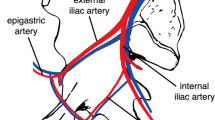Abstract
Purpose
We evaluated the corona mortis (CM) anatomy by means of three-dimensional computerized tomography angiographic (CTA).
Methods
Patient demographic, anastomosis incidence, artery diameter, artery distance from the symphysis pubis, and pelvic size (distance between both acetabular upper labrum) parameters were assessed. The 100 patients included 66 males and 34 females (average age of 67.8 years).
Results
There were 66 (33%) arterial anastomoses in the 200 evaluated arteries, 30 in the right side and 36 in the left side, 36 unilaterally and 15 bilaterally. No anastomoses were detected in 49 patients. The average diameter was 2.4 mm for the right-sided arteries and 2.24 in the left-sided ones. The distance was 55.2 mm from the right symphysis and 57.2 from the left symphysis (greater for females, 62.2 versus 55.85 mm [p = 0.037] only on the left side). The artery disappears in smaller-sized pelvises. There was a non-occluded arterial pattern in 47 (71%) and a partially occluded one in 19 (29%, all with peripheral vascular disease).
Conclusion
One-third of the evaluated CTAs revealed competent CMs. CMs were more lateral in females than in males and were absent in small-sized pelvises. It is highly recommended that the radiologist and the surgeon should be familiar with CM existence for decision-making with regard to emergency radiology imaging and intervention as well as when operating in proximity of that anatomic site.




Similar content being viewed by others
References
Darmanis S, Lewis A, Mansoor A, Bircher M (2007) Corona mortis: an anatomic study with clinical implications in approaches to the pelvis and acetabulum. Clin Anat 20:433–439
Okcu G, Erkan S, Yercan HS, Ozic U (2004) The incidence and location of corona mortis: a study on 75 cadavers. Acta Orthop Scand 75:53–55
Rusu MC, Cergan R, Motoc AGM, Folescu R, Pop E (2010) Anatomical consideration on the corona mortis. Surg Radiol Anat 32:17–24
Teague DC, Graney DO, Routt MLC Jr (1996) Retropubic vascular hazards of the ilioinguinal exposure: a cadaveric and clinical study. J Orthop Trauma 10:156–159
Tornetta P 3rd, Hockwald N, Levine R (1996) Corona mortis. Incidence and location. Clin Orthop Relat Res 329:97–101
Karakurt L, Karaca I, Yilmaz E, Burma O, Serin E (2002) Corona mortis: incidence and location. Arch Orthop Trauma Surg 122:163–164
Smith JC, Gregorius JC, Breazeale BH, Watkins GE (2009) The corona mortis, a frequent vascular variant susceptible to blunt pelvic trauma: identification at routine multidetector CT. J Vasc Interv Radiol 20:455–460
Rehder P, Glodny B, Pichler R, Mitterberger MJ (2010) Massive retropubic hematoma after minimal invasive mid-urethral sling procedure in a patient with a corona mortis. Indian J Urol 26:577–579
Gobrecht U, Kuhn A, Fellman B (2011) Injury of the corona mortis during vaginal tape insertion (TVT-Secur™ using the U-approach). Int Urogynecol J 22:443–445
Garrido-Gómez J, Pena-Rodríguez C, Martín-Noguerol T, Hernández-Cortes P (2002) Corona mortis artery avulsion due to a stable pubic ramus fracture. Orthopedics 35:e80–e82
Mahadevan V, Niranjan NS (2009) Sexual differences in the pelvis; chapter 79: pelvic girdle and lower limb: overview and surface anatomy. In: Standring S (ed) Gray’s anatomy, fortieth edn. Curchill Livingstone Elsevier, Edinburgh, pp 1359–1560
Author information
Authors and Affiliations
Corresponding author
Ethics declarations
The CTA study was approved by our institute ethics committee and was performed according to a standard protocol.
Conflict of interest
The authors declare that they have no conflict of interest.
Rights and permissions
About this article
Cite this article
Steinberg, E.L., Ben-Tov, T., Aviram, G. et al. Corona mortis anastomosis: a three-dimensional computerized tomographic angiographic study. Emerg Radiol 24, 519–523 (2017). https://doi.org/10.1007/s10140-017-1502-x
Received:
Accepted:
Published:
Issue Date:
DOI: https://doi.org/10.1007/s10140-017-1502-x




